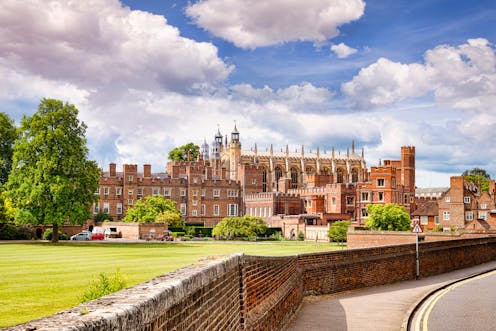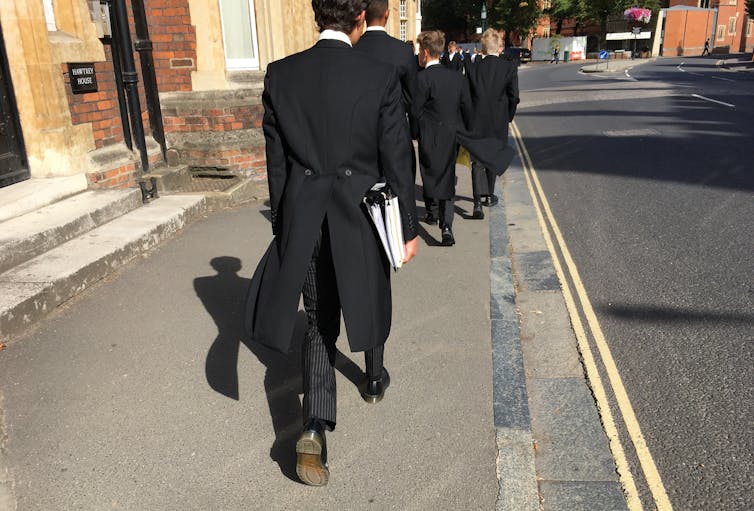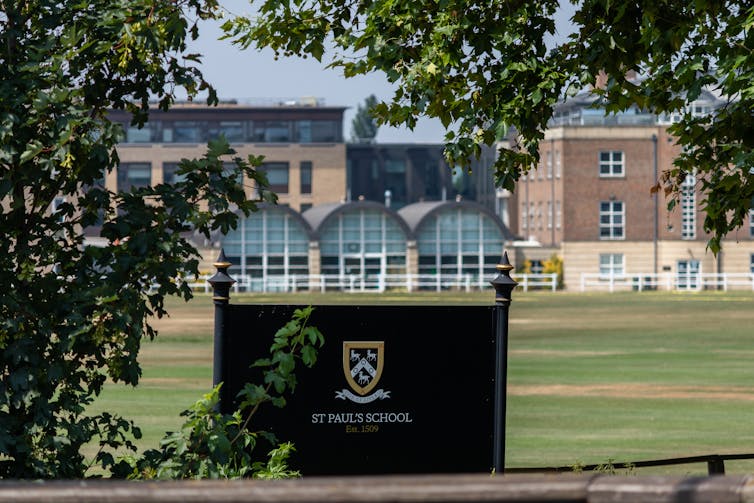
Some UK private schools appear to be taking advantage of their charitable status and the lax legal definition of “public benefit” by charging fees that are increasingly out of kilter with their ongoing costs.
Around 1,300 UK private schools, including the vast majority of the most prestigious private institutions, enjoy long-standing charitable status. This gives them substantial tax advantages but obliges them to use their charitable resources for public benefit.
Our research, conducted over the last four years, focuses on how these schools acquire, sustain and use their wealth, and on the associated thin transparency and accountability regimes that have endured for more than a century. (Responses received are collated at the end of this article.)
We found that some of these schools have more than doubled their fees over the past two decades, which appears to indicate that they are pricing by what parents can pay, rather than their actual costs.
Charging very high fees while offering discounts (known as fee remissions) that mostly benefit the already-wealthy can be justified as lawfully charitable and delivering public benefit under the loose regulatory environment created by English charity law. Furthermore, the limited nature of the level and reach of fee remissions is often obscure, given their – quite legitimate – treatment in private schools’ financial accounts.

This story is part of Conversation Insights
The Insights team generates long-form journalism and is working with academics from different backgrounds who have been engaged in projects to tackle societal and scientific challenges.
While less than 7% of pupils attend private schools in the UK, in 2020 more than 31% of students at Oxford University were privately educated. This educational disparity is effectively subsidised by all UK taxpayers through a broad range of tax exemptions available to private schools with charitable status. The UK also subsidises universities by a roundabout route, meaning that privately educated students pay to get access to a state-subsidised system.
It is not possible to state with certainty how much the UK’s charitable private schools save through tax exemptions. However, a good estimate according to our research is around £3 billion a year. This equates to more than 6% of England’s total state school budget (£47.6 billion) in 2020-2021.
Meanwhile, the UK parliament’s Public Accounts Committee reported in March that severely straitened finances have seen many state schools in England narrowing their curriculum offerings, dropping subjects, cutting staff and reducing support for pupils with special educational needs and disabilities.

An air of exclusive luxury and privilege
At Millfield, a full range of academic and instrumental tuition is offered in a purpose-built Music School … Millfield is fortunate to have the Johnson Hall, our 350-seat Concert Hall with superb acoustics and a stage large enough to host a full orchestra and choir. The Johnson Hall Steinway D Piano was recently described by international artist Pascal Rogé as ‘among the ten best pianos I have ever performed on’. (Extracted from the Millfield School website)
Music education is culturally and socially enriching for children, and deemed a vital part of a well-rounded education. Millfield, a high-fee private school in south-west England, is a member of the Headmasters’ and Headmistresses’ Conference (HMC) – a powerful lobby group of private schools. Most HMC schools have similarly abundant music offerings.
These provisions stand in stark contrast to the parlous music offering in state schools. A survey conducted by UK Music found that 50% of children at independent schools receive sustained music tuition, while the figure for state schools is 15%. Furthermore, 17% of “music creators” were educated at fee-paying schools, compared with 7% across the population as a whole.
The intellectual, cultural and social advantages accruing to private school students through music education are echoed in all other curriculum fields, from the performing arts to sport to STEM subjects.
UK private schools generally possess lavish facilities and infrastructure. Brighton College commissioned a world-leading architect, OMA – whose other buildings include the London Design Museum and Moscow’s Museum of Contemporary Art – to design its new £55m Sports and Science Centre. Opened in 2020, it features:
a cinema-style auditorium linked up to science departments across the globe, 18 university-standard laboratories, six breakout spaces for personal research and tutorials, a 25-metre pool, a strength and conditioning suite, a rooftop running track with panoramic views, and a double-height sports hall. (Extracted from the Brighton College website)
A couple of miles down the road, Roedean School noted of its refurbished boarding facilities in 2015 that “each house is adorned with artwork and a palette of House colours, and complemented with a mix of new and period furniture”.
Roedean has utilised its superlative facilities to create an air of exclusive luxury and privilege. In one annual report, the school quoted high-society magazine Tatler’s exclamation that “Roedean now has the swankiest boarding facilities in the country, perhaps in the universe”. Such abundance is a common feature of private schools’ marketing strategies.
The increasing asymmetries between state and private provision in the UK severely skew educational, cultural and social outcomes. Such disparities led Finland to outlaw charging for education nearly 50 years ago. In contrast, some UK private schools have used their charitable status and formidable networks to achieve a “virtuous money circle” that is effectively being subsidised by all UK taxpayers, while benefiting a small minority of predominantly wealthy families. And while they offer some fee remissions for those unable to pay their full fees, our research suggests these usually do little to make the schools less exclusive.
Charitable status, public benefit and tax
Charities in England must have charitable purposes, and for more than 400 years, English law has recognised education as such a purpose. Charities must also deliver public benefit with their resources – but this term is only loosely defined in law. This effectively permits private schools to allocate most of the benefits of their land, buildings, facilities and scholarships to a small group of significantly better-off families who can afford the school fees.
For a century or more, charities have been exempted from a broad range of taxes – a form of public expenditure known as “tax expenditures”. Rather than collecting taxes and then spending the money on public services, the government simply excuses certain classes of taxpayers (in this case, charitable private schools) from paying tax in the first place.
Such tax expenditures are largely invisible because they are not measured, and no specific budget allocations are made and subjected to parliamentary scrutiny. Private schools are, in practice, subject to little or no accountability with regards to the effectiveness or equity with which they use this cash.

Charitable resources intended for public benefit and the considerable tax savings enjoyed by many private schools help provide luxurious facilities. In turn, young people from families wealthy enough to pay the high fees generally gain disproportionate access to top universities and subsequent life chances, in part through the “old school tie” networks.
Indeed, a representative of the Old Marlburian Association (the alumni association for Marlborough College) told The Times in 2019 that:
Parents now expect that what they pay for is not just five years of teaching but lifetime membership to a special club. It’s the reason people decide to send their kids to public schools and not to the local academy, where they may very well perform better academically.
The fact that privately schooled students are remarkably over-represented at top universities is, in part, because these schools’ essential selection criterion is family income, which usually ensures that students already have considerable cultural capital. Other selection criteria may include tests and interviews.
The schools’ wealth also gives their students significant advantages in terms of an abundant supply of quality curriculum materials, small class sizes and intensive teaching, plus a potential benefit from the schools’ ability to “game the system”.
The fact that UK higher education is still significantly state-subsidised means, in effect, UK taxpayers continue to fund privately educated students during their university studies. Such students’ disproportionate representation is a serious opportunity-loss for state students, many of whose schools are suffering real financial hardship that negatively impacts their students’ educational and career outcomes.
Private schools’ sources of income
Private schools have three primary sources of income.
1. Fees
Fees charged to families are the major source of private schools’ income. Fees may not seem a legitimate public concern – people can spend their money as they please. But the links between fees and the schools’ charitable obligations need to be unpacked.
Private school fees are high relative to average UK incomes. In 2018, average annual fees in day and boarding schools were nearly £15,000 and £33,000 respectively. In real terms, fees have more than doubled over the last 25 years. These price points serve to exclude lower-income families. The fee increases also match marked rises in the disposable income of wealthier families in the UK, and the increased recruitment of students from wealthy overseas families – in particular from Russia and China.
Our research demonstrates, empirically, that many private schools charge much more than is strictly necessary for them to fulfil their charitable purposes of providing education. For example, comparing average day and boarding school fees by region, the differences between day fees in the cheapest and most expensive English regions could not be explained by costs alone. Specifically, while boarding school fee differentials (17%) were roughly equivalent to the difference in associated costs such as staffing, average day fees in the cheapest region were 35-40% lower than those in the most expensive.
Similarly, we found a stronger correlation between local gross disposable household income and day fees than with boarding fees. This suggests that day schools are particularly responsive to the disposable income levels in their catchment area.
But boarding school fees are also rising rapidly, as was highlighted in a recent Sunday Times report which suggested the average annual cost of sending a child to an English boarding school is now “approaching £50,000” due to planned fee increases for the next academic year.
The increasingly upmarket facilities of charitable private schools, such as those described earlier, may, in turn, be used to justify these rising fees. The vast majority of children from families with more modest incomes are excluded by this fee spiral from enjoying such facilities – which should, by law, be available for public benefit.
2. Tax reliefs
Private schools benefit financially from the tax exemptions that arise because of their charitable status. Their operating surpluses (profits) and capital gains (profits on the sales of investments including shares, land and facilities) are exempt from income tax, capital gains tax or corporation tax.
In England and Wales, private schools also receive an 80% discount on business rates (local taxes). Furthermore, they can claim 25% of all donations received (such as chancellor Rishi Sunak’s donations to his old school, Winchester College, which reportedly exceed £100,000) from the tax authorities in gift aid.
This suite of tax exemptions arose principally from a legal and public campaign conducted by the Headmasters’ Conference in the early 20th century, and have remained largely unquestioned ever since. Charities that provide education are also, under a 1977 EU Directive, exempt from charging VAT, while bequests to schools are exempt from inheritance tax.
The total scale of these tax expenditures is mostly unknown. The Labour Party estimated the annual value of VAT forgone by the state from charitable private schools was £1.6 billion in 2019. In 2021, it estimated the annual value of these schools’ business rates discount and income tax relief to be around £100m and £700m respectively. In all, we estimate the total value of private school tax exemptions could be in the region of £3 billion a year.
3. Investments and donations
Many private schools derive substantial income from invested funds and donations. Some of this income is derived from related charities whose purpose is to fund specific private schools, but which are separate for legal and accounting purposes. Whatever the source, this income is charitable in nature and must legally be used for public benefit.
In some cases, private schools hold significant investment portfolios accumulated over long periods of time. For example, the published financial accounts of Eton College and Winchester College show they have total reserves of £323,000 and £526,000 per pupil respectively.
In law, such investments must have a charitable purpose. Yet Eton, despite fees of £42,500 per student, still has to use investment income to help fund its spend on education. In reply to a request for comment on this article, the school confirmed: “The amount Eton spends on education is not met fully by fee income; a significant proportion of that expenditure comes from income from our endowment.” This means the school uses income from charitable assets to subsidise educational provision that it already generously funds through fees.
Sources of donations and fees
Across the private school sector as a whole, it is worth considering whether the sources of donations and fees are always legitimate, and if the potential exists for money laundering. In 2018, the UK’s National Crime Agency (NCA) asserted that money is being filtered through British private schools, and criticised schools for failing to flag suspicious payments to the government.
The recent sanctions placed on Russian citizens following the invasion of Ukraine again put a spotlight on the sources of school fees and donations – there are some 2,300 Russian children currently studying in UK private schools. However, these schools are not legally obliged to report suspected money laundering, and may also have limited capacity to carry out checks.
How private schools use their income
UK private schools are, on the whole, replete with financial resources. Because they are charities, they cannot pay out dividends (they have no shareholders) and their freely available (“free”) reserves must, in law, only be sufficient to enable them to carry out their charitable objectives.
Their remaining “restricted” reserves are funds that are held for charitable purposes – such as saving for a new building or funding bursaries. But charity law and accompanying guidance are not prescriptive, and simply require trustees to formulate reserves policies that justify a target level of reserves, and explain how they intend to achieve that target.
The accounting firm BDO has suggested that, across all charities, reserves policies are far from satisfactory. In the case of private schools’ accumulated reserves, there appears to be little action (or appetite) from the Charity Commission to address this issue. In short, these charitable schools are free to accumulate cash and have significant discretion as to how it is used.
One way to absorb cash that cannot be reasonably kept as free reserves is to incorporate it into more facilities of the type described earlier. Investment in luxurious infrastructure projects appeals to the schools’ target markets, potentially enabling them to charge even higher fees.
While a detailed analysis of schools’ expenditure on infrastructure is problematic, due to the unpredictable nature of such expenditure and the difficulty in distinguishing it from normal infrastructure renewal, the rise in private schools’ total annual capital expenditure from £247m in 1997 to £771m in 2013 (the latest reliable figure) supports this analysis.
What constitutes adequate provision for ‘the poor’?
English law requires that charities provide benefits to at least a significant section of the public. However, the Charity Commission advises that what constitutes “significant” is a matter of judgment.
In a landmark case in 2011, the UK’s Upper Tribunal ruled that the law “requires that those who benefit from the charity’s purpose must be sufficiently numerous to constitute ‘a section of the public’”. While school-age children obviously constitute a significant part of the public, fee levels exclude a very large proportion of them. How, then, are private schools not in breach of their public benefit obligations?
The Upper Tribunal ruled that, in making adequate provision for “the poor”, consideration should be given as to whether the charity in question provides a “luxury” service. Its judgment stated that, while the provision of luxury facilities is no bar to charitable status, there is a greater onus on private schools to demonstrate how they provide a public benefit.
However, Charity Commission advice does not prescribe any limits either to the degree of luxury which may be provided, or the maximum level of charges. And the Upper Tribunal ruled that “the poor” does not just include those who meet official definitions of poverty. Its definition extended to those of “modest means” – defined as those who could not afford the school’s full fees. Given the current high levels of school fees, such families may be far from poor by official measures.
Read more: Would abolishing private schools really make a difference to equality?
Crucially, decisions as to what constitutes adequate provision for “the poor” are at the discretion of individual school trustees. Charitable private schools stay on just the right side of a fuzzy legal line in deciding who benefits from the resources they generate from fees and other income sources, such as tax reliefs and investment income.
But, these schools were given short shrift by the Upper Tribunal in 2011 for arguing that, simply by relieving the state of the cost of educating their students, they were delivering public benefit. And while many private schools allow local communities to use their facilities, such as swimming pools, the Upper Tribunal stressed this does not provide public benefit as it has no direct educational purpose. With its more recent plans to sponsor selective academy schools, Eton College might fare better on perceived public benefit provision.
Who qualifies for private schools’ reduced fees?
Mostly, charitable private schools seek to demonstrate their public benefit through fee remissions and complete exemptions. These may be means-tested, awarded based on academic, musical or sporting talent, or given as discounts for families with more than one child at the school, or to the children of staff. Again, these decisions are at the trustees’ discretion, within the law.
In 2011, the Upper Tribunal set no minimum level of total fee remissions, stipulating only that it must be more than “merely token”. Our analysis reveals that in 2018-19, UK private schools awarded fee remissions totalling just over £1 billion to 176,234 out of their 537,315 students. Analysis of all fee remissions awarded by the 192 HMC schools in 2019 shows a median value of 10.4% of total fees.
Of this £1 billion, some £440m – 44% of the total fee remissions – was means-tested. The proportion of fees discounted on this basis ranged from 1.7% to 15%, with the median at just 5.1% (for the 142 HMC schools where the means-tested split could be identified). In all, our research shows the means-tested £440m was shared between 44,395 students – an average of around £1,000 a head.

Just 6,118 – 1.1% of all private school students – received a full scholarship, and a further 2.1% received fee remissions in excess of 75% of fees. Of the schools contacted during the writing of this article, St Paul’s School highlighted that 80% of its 147 bursaries are for between 75%-100% of the fees, and Eton highlighted that in the 2020-21 academic year, 90 of the 261 boys receiving fee remissions paid no fees at all. According to our research, these are uncharacteristically high percentages compared with the national average.
Importantly, while private schools may be proud of their scholarship provision, most provide no data on the demographic profiles of recipient students, making it impossible to evaluate the extent to which these benefit less well-off families. And given the high levels of fees, most students in receipt of means-tested fee remissions will still require very substantial family contributions.
For instance, St Paul’s offers fee assistance to families with an annual household income of less than £120,000, which can arguably be justified when the definition of “modest means” is being unable to afford fees of around £27,000 a year out of post-tax income.
Charging very high fees and giving fee remissions which mostly benefit those who could be considered to be already wealthy can certainly be justified as lawfully charitable and as delivering public benefit. But this is because of the loose regulatory environment created by charity law and associated accounting rules, and because of a simple lack of public transparency and accountability in the system.
Read more: Get rid of private schools? We'd be better tackling inequalities between state schools
Furthermore, the limited nature of the level and reach of fee remissions may be obscured by their – quite legitimate – treatment in private schools’ financial accounts. For example, if full fees are £15,000 per year and a 50% deduction is awarded, the schools show (either on the face of the Income & Expenditure account or in a note) gross fees of £15,000 and the remission of £7,500 as a deduction from that figure. However, the additional cost to the school of teaching that pupil is likely to be lower than the valuation placed on the fee remission, because schools’ costs are largely fixed or stepped (for example, when an extra teacher is required). But there is, of course, an opportunity cost to the school of replacing a full-fee place with a student paying a reduced fee.
There is a relative dearth of accountability around the finances of charitable private schools, despite the public funding they receive through tax reliefs and their public benefit obligations. The UK government collects no data on the value of tax expenditures received by the schools, and our analysis of the (limited) scale and distribution of private school scholarships was highlighted in the House of Lords in May 2021 as a cause for concern.
Discussing the private school sector, Andrew (Baron) Adonis said in his speech that “what starts off as a hugely privileged sector, even in the work that it does that is supposed to be charitable – in relieving fees and giving access to these charitable assets – is not meeting those objectives”.
So what could be done?
The financing of the UK’s charitable private schools is a matter of public interest and concern. These schools have public benefit obligations regarding their use of charitable assets, yet some fees indicate that private schools are indulging in market pricing, excluding nearly all but the wealthiest from any charitable benefit. In addition, the schools receive substantial benefits by being exempt from a wide range of taxes.
Given the current state school funding crisis, it can be argued that educational resources are being misapplied as a result of private schools’ charitable status, exacerbating educational inefficiencies and social injustice. For anyone seeking to address these issues, our research leads us to the following conclusions:
(1) The UK government should introduce robust systems of transparency and accountability for charitable private schools, regarding how their charitable assets are used and by whom, and the extent and distribution of the tax reliefs the schools enjoy. For example, private schools could be required to report demographic data on the recipients of their public benefits along with the results of independent stakeholders’ evaluations. Collated nationally, such data would provide an important input into debates on education funding.
(2) The UK government should also consider withdrawing the tax exemptions enjoyed by these schools (Scotland has already withdrawn their business rates discounts). In 2020-21, total spending on state schools in England and Wales was £47.6 billion. If tax exemptions for private schools, were removed, the resulting increased taxes could be redistributed to state schools, increasing their budget by around 6%, thereby making a significant contribution to the government’s levelling up agenda.
(3) The charity status of these private schools should be reviewed. They are, for the most part, elite organisations delivering a paid-for and exclusive product. The extent to which this meets public perceptions of “charity” is questionable. Of course, removal of charitable status would mean making new arrangements for the assets the schools hold, as they could not legally retain control of charitable assets such as investments and buildings. Control of these assets might be transferred to, say, a national education trust for the benefit of all UK school students. In part, this could be achieved by renting back the buildings and facilities to the private schools where they are located, with the rental income raised then being distributed throughout the state school system.
(4) Finally, higher education policies on university access need to specifically address issues associated with the disproportionate representation of private school students. The UK government has, for some time, devoted considerable resources to widening higher education participation, with its main policies encouraging disadvantaged students to gain access and achieve success. Such policies effectively ignore the opportunity costs borne by state educated students because of charitable private schools’ tax exemptions and other benefits.
Any attempts to effect change will, however, inevitably be met with significant pushback. Over at least two centuries, the UK’s private schools have successfully mobilised charity and tax law to their advantage. Yet this exercise of power is effectively invisible to wider public view, due to the complexity of legal linguistics and processes, the pseudo-objectivity of the law, and the failure of parliament to make public expenditure on private education a matter of regular debate and accountability.
Responses to this article
All schools named in this article were offered the opportunity to comment on its key findings. The following schools offered comments, which are summarised here:
Eton College
“The amount Eton spends on education is not met fully by fee income; a significant proportion of that expenditure comes from income from our endowment. In our last financial year to 31 August 2021, Eton spent £7.081m on financial aid. 261 boys at Eton (19%) received fee reductions; 90 of these boys paid no fees at all. This year, that number is 103.
"We work with a number of external partners, including the Royal National Children’s SpringBoard Bursary Foundation, to ensure that our bursary programmes reach those who would most benefit. Since we are heavily oversubscribed by parents willing to pay the full fee, these costs are real costs, which we are proud to meet.
"Eton also has a large and expanding partnership programme. We are about to open three new state sixth-form colleges in partnership with Star Academies, which Eton will help to fund in perpetuity. We file detailed annual accounts with the Charity Commission. These are scrutinised by our Audit Committee and by our full governing body, in addition to being externally audited. Our Reserves Policy is set out in our published accounts.”
St Paul’s School
“Our Governors and committees are very engaged on reserve levels, public benefit and accountability – our parents expect it. For the next academic year, we are looking at a fee increase of 3.5%. This increase follows the decision of the governors to increase all staff salaries by 3%, with an additional amount for lower-paid staff members in order to meet cost-of-living increases. The Governors have a stated commitment to try to restrain our fee increases to remain in line with, or below, inflation.
"Fees rebates were provided during the first term of COVID remote learning (summer 2020) and again in the 2021 spring term (which many parents donated back to our bursary appeal). Regarding families with modest incomes being excluded from fee remissions, 80% of our bursaries are for 75-100% bursaries, meaning the majority of the 147 bursaries currently awarded are for those most in need. Fee remissions are shown as a deduction from gross fee income in the notes to the accounts, and then the remissions coming from restricted donations are added back – our understanding is that this is the same for all independent schools.
"In terms of ‘free reserves’ (reserves which are immediately available to spend), the school has none because our unrestricted reserves are tied up in buildings which, as you will understand, are not immediately realisable. As a charitable foundation we are not driven by profit, but equally we are committed to maintaining the resources of the school and the high educational provision which we were founded in 1509 to provide. Our partnership work through the West London Partnership – which we established – is substantial and growing.”
Roedean School
“In terms of our boarding facilities, the houses were in dire need of refurbishment as they had not been refurbished for many years and also required structural work to the building. Any residential accommodation needs to meet the required standards for boarding. We do put pupils’ artwork on the walls and House colours (red, blue, green, yellow) are used in the Houses, along with furniture (new and old). The Houses are the girls’ ‘homes’ and we want all girls to feel at home here. Tatler’s quotation reflects their magazine’s style.”

For you: more from our Insights series:
To hear about new Insights articles, join the hundreds of thousands of people who value The Conversation’s evidence-based news. Subscribe to our newsletter.
Malcolm James is affiliated with the Labour Party, but has not done any paid or unpaid work for them in this area.
Jane Kenway receives funding from the Australian Research Council
Rebecca Boden is a member of the Labour Party.
This article was originally published on The Conversation. Read the original article.







